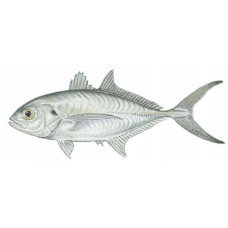Latin name
Caranx crysos
Other names
Hardtail, hard-tailed jack, runner; French: carangue coubali; Greek: kokali; Italian: carangidi, carangido mediterraneo; Portuguese: carangídeos, xaralete; Spanish: atún, cojinua, cojinúa negra, cojinuda.
Identification
The body is bluish-green to coppery-silver, silvery, or light olive. The upper end of the gill cover has a black, somewhat elongated spot, and the body may have faint bluish streaks. A characteristic feature is a blackish tint on the tips of the tail fins. The fish can be easily distinguished from crevalle jack by the absence of dark blotches on the pectoral fins.
Distribution
In the western Atlantic, they occur from Nova Scotia to Brazil, including the Caribbean and the Gulf of Mexico.
Habitat
They live in coastal waters in large flocks. Occasionally can be found over reefs, sometimes in pairs or alone. Young fish often stay near sargassum and other floating objects.
Size
This species usually weighs less than 1 pound and reaches 1 foot in length. The world record for all tackle is an 11 pound, 2 ounce fish caught off the coast of Alabama.
Life history and Behavior
Sexual maturity occurs when they reach a length of 9 to 10 feet, spawn in coastal waters from January to August.
Food and feeding habits
Feed mainly on fish, shrimp, squid and other invertebrates.
Reproduction
No information
| Classification | |
| Phylum | Chordata |
| Class | Actinopterygii |
| Squad | Carangiformes |
| Family | Carangidae |
| Genus | Caranx |
| Species | C. crysos |
| Features | |
| Conservation status | Least Concern |
| Habitat | Pelagic |
| Life span, years | No information |
| Maximum body weight, kg | 5.1 |
| Maximum length, cm | 70 |
| Sailing speed, m/s | No information |
| Threat to people | Edible |
| Way of eating | Predator |



